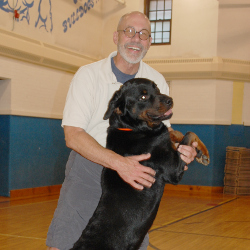By Jim Lessenberry
A year before I was born in 1955, a television classic debuted. Lassie, a rough coat Collie, was a rural superhero. "Lassie," the television program, is pragmatically summed up by June Lockhart, who played Ruth Martin (1959-64), mother of young son Timmy and their family dog Lassie, as "…a fairy tale about people on a farm in which the dog solves all the problems in 22 minutes, in time for the last commercial."
No, Lassie, the cross-dressing Collie (the female role always played by male dogs), had nothing to do with my eventual vocation as an animal behaviorist, but I always think of June Lockhart, when people snicker, "a dog shrink?"
It was not long ago that our family values saw dogs as chattel, personal property and not a part of the family. But, in the last few generations, there has been a shift in families moving from the farm to the cities and then the suburbs, and today, with the renaissance of Detroit, we find dogs in the even-more dense living quarters of apartments, lofts and condos. And with that shift in environments we call home, our relationship with our dogs has evolved by forcing us to live closer, spend more time together and, most importantly, develop a personal and emotional relationship with the animal that defines us as family.
We have discovered a value in our dogs that extends beyond the utilitarian functions of hunting, herding and security. We have come to value the emotional relationship they allow us and, as humans, we empathize with their dilemmas and feel guilt for their unmet needs.
 MAVERICK, a 6 year old Rottweiler and popular Family Training Course teaching assistant, gets a well deserved hug after a day's work.
MAVERICK, a 6 year old Rottweiler and popular Family Training Course teaching assistant, gets a well deserved hug after a day's work.Enter the animal behaviorist.
My first career in the 1970s and early '80s was in information technology. I assessed organizations and systems and designed software for intelligent automation. In time, thinking about thinking and behavior lead me to study the biology and psychology of learning and memory in living organisms. As an emerging yuppie, I had the requisite house in the suburbs, a backyard,Hobo was a stray taken in after days of seeing him wandering the rail tracks near my house and became my first child surrogate. His life with me overlapped my career transition and I soon saw how my new academic insights could be applied to the family pet. Applying my trade gave me a very well mannered dog that turned heads and elicited compliments from everyone he met.
Soon I was helping others to train their dogs in the basic tricks of: "sit," "come," "down," "stay," and household rituals like stay off the furniture and where to poop. As I coached families to teach their dogs these tricks, I saw that having physical control alone did not necessarily make for a well-mannered dog. I also saw the infinite variation in behavior, temperament, personality and emotion in these animals; along with the variations in behavior, personality, emotion, and expectations of the people they were living with.
I was hooked.
I began training dogs professionally in 1986 and was practicing clinical animal behavior by 1989. Thirty years of happy clients speaks to the profession's legitimacy. Animal behavior therapy is a little art backed up by a lot of science.
When dogs are fighting, biting, fearful, anxious, depressed, unruly, difficult to train, or exhibit truly bizarre behaviors, or are faced with challenges like deafness, blindness, or the cognitive deficits of old-age, a clinical animal behaviorist begins with an assessment of the ecology of the situation. Artfully, the assessment is interpreted against an understanding of the central, peripheral and autonomic nervous systems, behavioral genetics, endocrinology, and developmental issues that effect emotion and motivation.
The holistic approach of the clinical animal behaviorist involves the entire family, the animal, and the veterinarian when disease states or physiologic issues suggest benefit from further medical testing, procedures, or the use of pharmacologic treatments. Clinical animal behaviorists keep abreast of the science of behavior and learning, behavioral pharmacology, and technology.
Combine all of these with a complete understanding of the household, its players, expectations, and capabilities and the clinical animal behaviorist is better equipped to understand, make predictions, and implement successful strategies that are practical, affordable, safe and humane for the entire family.










